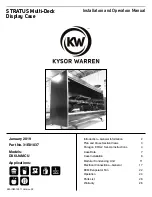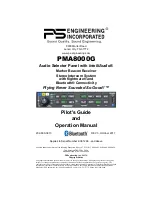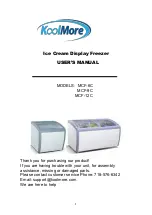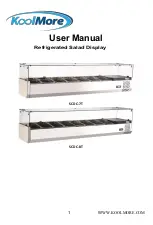
FMA Direct
3
Co-Pilot II reference manual
General safety precautions
Radio controlled models are not toys! Please observe these gen-
eral safety precautions:
n
Follow all instructions in this manual to assure safe operation.
n
If you have not assembled and operated a radio controlled
model before, obtain help from an experienced modeler. You
will need guidance to successfully assemble, test and operate
radio controlled models. One of the best ways to obtain help
is to join your local radio control club.
n
Never fly radio controlled aircraft near people, buildings, tele
-
phone or power lines, cars, trees or other objects on the ground
or in the air.
n
Never allow a helicopter to fly within 20 feet of you or another
person. If a helicopter flies toward you or another person, stop
the engine or motor immediately to prevent personal injury.
n
Keep your radio controlled models and equipment away from
children. Do not allow unauthorized people of any age to op
-
erate radio controlled models without proper supervision from
an experienced modeler.
n
In many areas of the country, you cannot legally operate radio
controlled models except at approved fields. Check with local
authorities first.
n
When using an FM or PCM transmitter, observe frequency
control. If someone else is operating a radio controlled model
on the same channel as your transmitter,
do not turn on your
transmitter—even for a short time
. Your transmitter has a
channel number marked somewhere on its case. When a mod-
el receives signals from two transmitters on the same channel
at the same time, it cannot be controlled and will crash—pos-
sibly causing personal injury or property damage.
For safety,
most RC flying fields have formal frequency control rules.
Follow them carefully.
n
Do not operate your FM or PCM radio control transmitter
within 3 miles of another flying field. Even at a distance, your
transmitter can cause interference.
n
Do not operate radio controlled models and equipment in the
rain, or at night.
n
Protect all electronic equipment from exposure to rain, water,
high humidity and high temperatures.
n
FMA Direct recommends that you join the AMA. They can
help you find a club in your area.
Academy of Model Aeronautics
5161 East Memorial Drive
Muncie, Indiana 47302
Phone: (800) 435-9262
Web: www.modelaircraft.org
Flight stabilization safety precautions
n
Co-Pilot™ II is designed for flight stabilization only. It cannot
navigate the aircraft or prevent a stall. You must control the
aircraft’s flight path.
n
Co-Pilot II is for recreational use only. Do not install Co-Pilot
II in aerial photographic aircraft where there is a possibility of
flying over people.
n
You must mount the Main Sensor Module and optional Verti-
cal Sensor Module securely. If a Sensor Module comes loose
during a flight, the aircraft will crash. Carefully follow the
mounting guidelines in this manual.
n
Keep fuel off the Sensor Modules. Fuel on the infrared sen-
sors can affect Co-Pilot II operation for as long as 10 minutes.
n
Besides your regular preflight check, also perform the Co-Pilot
II preflight check before each flight. Details are in “At the
field,” later in this manual.
n
If you are not using the optional Vertical Sensor Module, per-
form a manual infrared calibration at the beginning of each
flying session, and repeat the calibration if there are major
weather changes. Details are in “Preparing to fly,” later in this
manual.
Safety precautions
Co-Pilot™ II specifications
Operating voltage
+3.5 to +9 volts DC
Operating current
<10 milliamps (servos may draw more
current from rapid movement and stabi-
lization)
Weight
Computer: 0.61oz (19gm)
Main Sensor Module: 0.23oz (7gm)
Vertical Sensor Module: 0.16oz (5gm)
IRNet Router: 0.26oz (8gm)
Sensor field of view
60° radius cone from window centerline
Leveling response time
1/60th second
Drift from level
<2°
Flying conditions
Day and night; all weather conditions
(rain, fog, sleet and snow may degrade
performance)
Humidity
Sensor is sealed; keep windows clean
Remote activation
On/off control and selection of Flight
Modes
Aircraft types
Works with all aircraft configurations, in
-
cluding dual aileron servos, quad flaps,
elevons, V-tail, VTOL complex transmit-
ter mixes, digital servos and CCPM

























